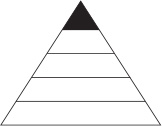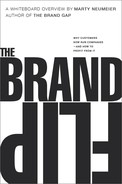INTRODUCTION
One of the more stunning insights in the theory of management came from Peter Drucker, a practical visionary who changed business discourse with his 1973 book THE PRACTICE OF MANAGEMENT. He said that a business has only one valid purpose: to create a customer.
What’s more, he said, if the purpose of a business is to create a customer, then it has only two basic functions—innovation and marketing. Innovation produces the products, and marketing tells the stories that sell them. These two activities drive results, and all the others are costs.
Drucker was ahead of his time. The discipline of branding had been stuck in the Industrial Age, and lacked strategic subtlety. He couldn’t have known that someday it would gather up the very concerns he was talking about—innovation, marketing, and the primacy of customers—into a tool-box of principles that could be studied, practiced, and improved over time. Or that the word BRAND itself would become shorthand for the Drucker way of thinking.
Thirteen years ago I tried to redefine branding in my book THE BRAND GAP, and took it further in my next book ZAG. As of this writing, THE BRAND GAP’S principles have been viewed online by more than 10 million people, and ZAG has been named one of the top 100 business books of all time. These volumes have stayed relevant, and continue to form the basis of my work.
Then why write another book? Because the rapid advance of technology, rather than making THE BRAND GAP and ZAG seem dated, has made them seem timid. For me, they occupy the odd position of being visionary and incomplete at the same time. In my world of workshops and keynotes, they’ve ceased to scratch the itch.
When I wrote THE BRAND GAP, the term SOCIAL MEDIA wasn’t in popular use. Neither were VIRAL, SMARTPHONE, TABLET, DISRUPTION, TRANSPARENCY, and SELFIE. Back then the central problem of branding was how to align business strategy with customer experience. Today it’s how to empower the customers who will drive your success.
“We believe putting customers first is the only way to create lasting value for shareholders,” said Amazon CFO Tom Szkutak. Amazon is one of a growing number of companies that have adapted to—and encouraged—the primacy of customers.

To the degree that the customer is boss, shouldn’t we know what the boss wants? The best customers are no longer consumers or market segments or tiny blips in big data. They’re individuals with hopes, dreams, needs, and emotions. They exercise judgment, indulge in whims, express personal views, and write their own life stories. They’re proactive, skeptical, and creative. They’ve reached the top of Maslow’s Pyramid, where the goals are autonomy, growth, and fulfillment. They don’t “consume.” HAVING more runs a distant second to BEING more.
An explosion of connectivity, and the power it gives customers, is turning companies upside down. The question isn’t WHETHER your industry will be disrupted, but WHEN. Companies today have a stark choice: they can leap into future and possibly land on their feet, or they can wait for roiling disruption to upend them.
This is the challenge of the brand flip.

To better understand what has changed in brand building, it might help to look at old and new diagrams on the left page. The old model of brand was based on the logic of factory management. The company created the brand (through products and advertising), the brand attracted customers (as a captive audience), and customers supported the company (through repeat purchases).
The new model of brand is similar, but with one important difference: the order of events. Instead of creating the brand first, the company creates customers (through products and social media), then the customers create the brand (through purchases and advocacy), and the brand sustains the company (through customer loyalty). This model takes into account a profound and counterintuitive truth: a brand is not owned by the company, but by the customers who draw meaning from it. Your brand isn’t what YOU say it is. It’s what THEY say it is.
In the pre-flip days, a company could find a hole in the market, fill it with a product, determine a price, and drive the product into people’s lives with heavy advertising and distribution. The only choice customers had was to buy or not to buy. The real power lay with the company and its leaders, who were seen as authority figures.
Today’s customers reject that authority, and at the same time require a measure of control over the products they love. They no longer BUY brands. They JOIN brands. They want a vote in what gets produced and how it gets delivered. They’re willing to roll up their sleeves and help out, not only by promoting the brand to their friends, but by contributing content, volunteering ideas, and even selling products or services. Many of them know more about the company, its products, its pricing, and its competitors than the CEO and employees do. In a very real sense, the best customers are co-leading companies into the post-flip world.
Each of the 18 chapters describes a single flip—an accepted business “truth” upended by technological change. These individual flips add up to the overall flip. Yet this book is not just a description of change, but a prescription for it. At the center is a simple matrix for modeling the relationship between your company and its customers. To demonstrate the matrix, I’ve added the example of a hypothetical tea company—a modest startup that would surely languish in obscurity under the old model of branding.
But what would happen if we flipped it?
